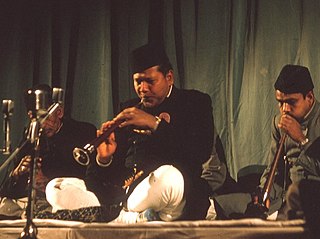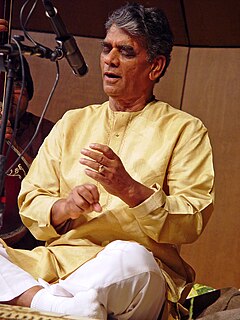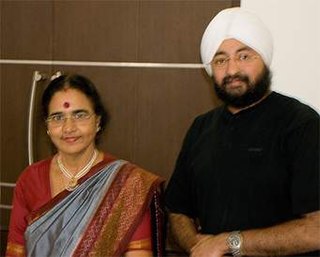Related Research Articles

Banaras Hindu University, formerly Central Hindu College, is a public central university located in Varanasi, Uttar Pradesh. It was established jointly in 1916 by the Maharaja of Darbhanga Rameshwar Singh, Madan Mohan Malaviya, Sunder Lal and British Theosophist and Home Rule League founder Annie Besant. With over 30,000 students residing in campus, it is the largest residential university in Asia.

Ustad Qamruddin Bismillah Khan, often referred to by the title Ustad, was an Indian musician credited with popularizing the shehnai, a subcontinental wind instrument of the oboe class. While the shehnai had long held importance as a folk instrument played primarily [schooled] in traditional ceremonies, Khan is credited with elevating its status and bringing it to the concert stage.
Ram Chandra Shukla (1925–2016) was an Indian painter and art critic.
Samikshavad is the first indigenous art movement in modern India, which started in North India in 1974. It has a different identity from the western movements of art. It is neither affected nor inspired by western art.
Lalmani Misra was an eminent Indian classical musician known as much for his art as for his scholarship.

Pandit Laxmi Ganesh Tewari is a Hindustani vocalist from India. He is an exponent of the Gwalior gharana (tradition) of vocal music. After studying with Dr. Lalmani Misra at Banaras Hindu University in Varanasi, he pursued education and teaching opportunities in America. At Sonoma State University since 1974, his career has combined performance, scholarship and teaching.
Pandit Kishan Maharaj was an Indian tabla player who belonged to the Benares gharana of Hindustani classical music.
Pt. Sitaram Chaturvedi, also known as Acharya Sita Ram Chaturvedi, was an eminent Indian educator, dramatist and scholar of Hindi and Sanskrit language and literature.
The Nagari Pracharini Sabha, also known as Kashi Nagari Pracharini Sabha, was an organization founded in 1893 at the Queen's College, Varanasi for the promotion of the Devanagari script over the more common Kaithi script.
Pandit Balwant Rai Bhatt was a noted Indian composer and musician of Hindustani Vocal Music. He was also known as Bhavrang (भावरंग). He died at his home in Varanasi on 2 May 2016.

N. Rajam is an Indian violinist who performs Hindustani classical music. She remained professor of Music at Banaras Hindu University, eventually became head of the department and the dean of the Faculty of Performing Arts of the University.

Pt. Omkarnath Thakur, was an Indian music teacher, musicologist and Hindustani classical singer. A disciple of classical singer Vishnu Digambar Paluskar of Gwalior gharana, he became the principal of Gandharva Mahavidyalaya, Lahore, and later went on become the first dean of the music faculty at Banaras Hindu University.He also wrote book "sangeetanjli" vol 1 to 6
Prem Lata Sharma was an eminent Indian musicologist, vocalist, scholar, Sanskritist and educator. As a vocalist, she trained under Pt. Omkarnath Thakur. She was born in Punjab and completed her doctorate in the Banaras Hindu University. She started the India's first Department of Musicology at Banaras Hindu University in 1966.

Byomakesh Mohanty was an Indian artist and academic. After completing his science studies and graduating from Utkal University, Bhubaneswar, Orissa, he joined as a faculty of visual arts at Banaras Hindu University.

Ragini Trivedi is an Indian classical musician performing on vichitra veena, sitar and jal tarang. Daughter of the vichitra veena player and musicologist Lalmani Misra, she is an exponent of Misrabani and is the creator of a digital music notation system called Ome Swarlipi.
V. Balaji is an Indian violinist who performs Hindustani classical music. Presently he is a Professor of Violin at Banaras Hindu University, eventually became the Head and the Dean of the Instrumental department.

Bharat Kala Bhavan is a university museum located in Banaras Hindu University, Varanasi, India. It has been instrumental in the dissemination of knowledge on Indian art and culture. It is one of the important touristic attractions in the Banaras Hindu University and in Varanasi] city.

Parmeshwari Lal Gupta (1914-2001) was an Indian numismatist who collated previous research on Indian Numismatics in the post-Independence era.
References
- ↑ "Padma Awards" (PDF). Ministry of Home Affairs, Government of India. 2015. Archived from the original (PDF) on 15 November 2014. Retrieved 21 July 2015.